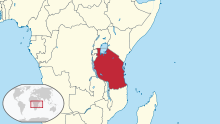Nymphaea stuhlmannii
| Nymphaea stuhlmannii | |
|---|---|

| |
| Botanical illustration of Nymphaea stuhlmannii in the publication "The waterlilies: a monograph of the genus Nymphaea" by Henry Shoemaker Conard | |
| Scientific classification | |
| Kingdom: | Plantae |
| Clade: | Tracheophytes |
| Clade: | Angiosperms |
| Order: | Nymphaeales |
| Family: | Nymphaeaceae |
| Genus: | Nymphaea |
| Subgenus: | Nymphaea subg. Brachyceras |
| Species: | N. stuhlmannii
|
| Binomial name | |
| Nymphaea stuhlmannii (Engl.) Schweinf. & Gilg[2]
| |

| |
| Nymphaea stuhlmannii is endemic to Tanzania | |
| Synonyms[2] | |
| |
Nymphaea stuhlmannii is a species of waterlily endemic to Tanzania.[2]
Description
[edit]Vegetative characteristics
[edit]Nymphaea stuhlmannii is an aquatic herb with 5–12 cm long, 3–4 cm wide, globose to ovoid, blackish brown rhizomes and white, long roots.[2] The 25.5 cm long, 21 cm wide, petiolate, ovate-orbicular leaves have an entire margin. The venation is prominent.[3]
Generative characteristics
[edit]The fragrant flowers are 10-15 cm wide.[3] They are yellow.[4] The four sepals are obovate. The 22 petals are broadly obovate. The androecium consists of 125 stamens. The gynoecium consists of 23 carpels.[3] The 3–4.5 cm long, and 4–6 cm wide fruit bears numerous ovoid 0.7–1 mm long, and 0.5–0.75 mm wide seeds.[2]
Taxonomy
[edit]Publication
[edit]It was first described by Adolf Engler as Nymphaea lotus var. stuhlmannii Engl. in 1895. Later, it was elevated to the status of a separate species Nymphaea stuhlmannii (Engl.) Schweinf. & Gilg by Georg August Schweinfurth and Ernest Friedrich Gilg in 1903.[2]
Type specimen
[edit]The type specimen was collected by Franz Ludwig Stuhlmann (1863-1928) in Uniamweni, Gunda mkali, close to Bibisande, Africa at 1200 m above sea level on the 16th of July 1890.[3]
Etymology
[edit]The specific epithet stuhlmannii honours Stuhlmann, who collected the type specimen.
Conservation
[edit]It is an endangered species (EN).[1] It was feared to be extinct.[5]
Ecology
[edit]Habitat
[edit]Nymphaea stuhlmannii occurs in shallow pools subject to seasonal droughts at an elevation of 1140 m above sea level. The rhizomes are exposed on the surface during the dry season.[2]
References
[edit]- ^ a b Mollel, N. 2024. Nymphaea stuhlmannii. The IUCN Red List of Threatened Species 2024: e.T185721A248552468. Accessed on 29 October 2024.
- ^ a b c d e f g "Nymphaea stuhlmannii (Engl.) Schweinf. & Gilg". Plants of the World Online. Royal Botanic Gardens, Kew. Retrieved 4 January 2024.
- ^ a b c d Conard, H. S. (2015). The Waterlilies: A Monograph of the Genus Nymphaea (Classic Reprint). pp. 161-162. USA: FB&C Limited.
- ^ Pring, G. H., & Woodson, R. E. (1933). A New Yellow Nymphaea from Tropical Africa. Annals of the Missouri Botanical Garden, 20(1), 1–6. https://doi.org/10.2307/2394418
- ^ Magdalena, C. (2018). "Der Pflanzen-Messias – Abenteuerliche Reisen zu den seltensten Arten der Welt. Deutschland:" Piper ebooks.

